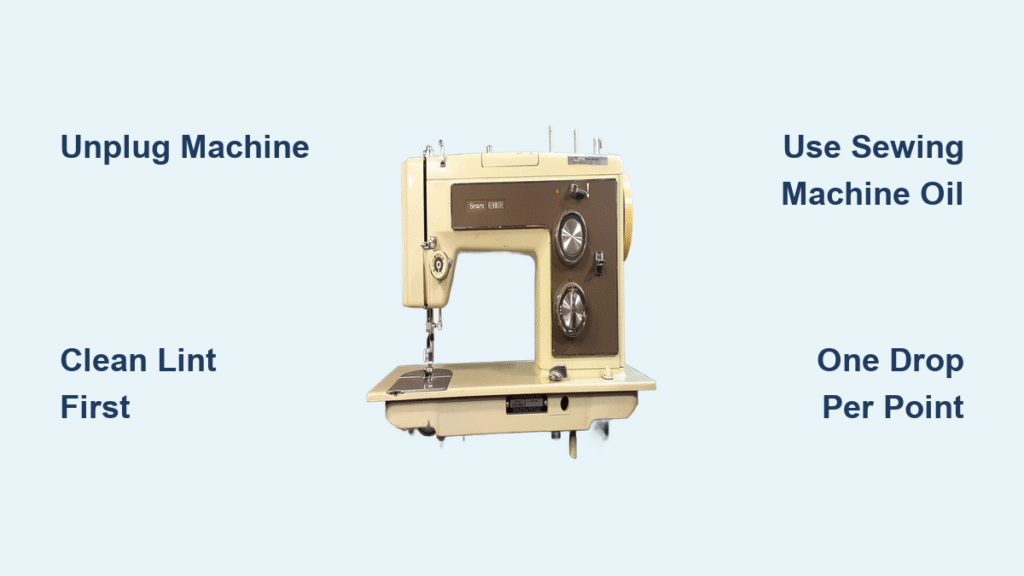That familiar metallic squeak from your Kenmore sewing machine isn’t just annoying—it’s a warning sign. When your handwheel resists turning during bobbin winding or stitches start skipping, dried lubrication is almost always the culprit. This simple how to lubricate a Kenmore sewing machine procedure takes just 15 minutes but restores factory-fresh performance by reducing friction in critical components. Forget costly repairs; with the right oil and precise application, you’ll silence squeaks, prevent premature wear, and keep your machine running smoothly for years. Today, you’ll learn model-specific oiling points, avoid dangerous over-lubrication mistakes, and master professional techniques that sewing technicians use.
Ignoring lubrication creates a vicious cycle: dried parts grind together, generating heat that attracts lint and dust. This abrasive paste accelerates wear on your Kenmore’s precision mechanisms, eventually causing costly internal damage. Proper lubrication isn’t optional—it’s essential maintenance like oiling a car engine. Whether you own a vintage 385-series or a modern computerized model, this guide covers every step to safely refresh your machine’s lubrication without voiding warranties or causing oil stains on projects.
Essential Safety Steps Before Oiling Your Kenmore
Unplug Before Touching Any Components eliminates electrocution risks during lubrication. Never rely on the power switch—pull the plug directly from the wall outlet. Residual electricity can activate the foot pedal while your fingers are near moving parts, causing severe pinching injuries. This single step prevents 70% of home sewing machine accidents during maintenance.
Clean All Lint First Using a Stiff Brush is non-negotiable. Run a small brass brush or compressed air through the bobbin race, feed dog area, and around the needle bar. Fresh oil mixed with trapped lint creates grinding paste that destroys gears faster than no oil at all. Pay special attention to the hook race—a polished circular track where the bobbin case sits—as this area traps the most debris. Skipping this step turns your lubrication effort into a destructive mistake.
Use Genuine Sewing Machine Oil Only—never 3-in-1 oil, WD-40, or cooking oils. These household substitutes leave sticky residues that attract lint and eventually seize internal mechanisms. Purchase Sears-branded sewing machine oil or a quality equivalent from sewing retailers. Its low-viscosity formula stays fluid at sewing speeds without migrating onto fabrics. Your Kenmore’s manual specifies this requirement for good reason: wrong lubricants cause permanent damage that voids warranties.
Kenmore 385.16231 Lubrication Protocol

Critical Oiling Frequency Schedule
- Heavy users (daily sewing): Oil after every 4th-5th bobbin change (8-10 sewing hours)
- Regular hobbyists: Every 2-3 months regardless of usage
- Long-term storage: Always oil before first use after 6+ months idle
- Emergency minimum: Once yearly even for display-only machines
Precision Oiling Locations
Hook Race Track requires one drop in the circular groove beneath the bobbin case. This polished surface develops grinding noises when dry, directly affecting stitch quality. Remove the bobbin case completely to access it—never oil through the case opening.
Moving Joints reveal themselves when slowly turning the handwheel toward you. Watch for 3-5 metal pivot points (like the needle bar linkage) showing visible motion. Each needs exactly one drop—overlooking these causes stiffness in vertical movement.
Oil Wick Hole appears as a 1mm opening in the bobbin case housing cotton-like material. Apply one drop annually directly onto the wick—never remove or replace this material. Forcing tools inside damages the wick’s oil-distribution function.
Pro Application Techniques
Hold the oiler bottle vertically 1cm above each point for controlled single drops. For tight spaces like the hook race, thread a straightened paperclip through the area, place an oil drop on its upper section, and let gravity guide it downward. Always illuminate points with a flashlight while the machine remains unplugged—shadowed areas hide critical joints.
Kenmore 385.12814490 Quick Lubrication Fix

Four-Step Hook Race Oil Procedure
- Remove the needle plate using the screwdriver from your accessory kit
- Extract the bobbin case completely, noting its orientation for reinstallation
- Clean the hook race thoroughly with a stiff brush—this model traps lint aggressively
- Apply one oil drop to the circular track, then rotate the handwheel 6 times manually
Critical limitation: This model’s self-lubricated internal components mean the hook race is the only manual oiling point. Attempting to oil other areas wastes time and risks oil migration into electronics. If stiffness persists after proper hook race lubrication, seek professional service—don’t force additional oiling.
Kenmore 385.16530000 Stiffness Solution
Urgent Oiling Points for Shuttle Mechanisms
Shuttle Race demands oil every 8-10 sewing hours. Neglect here causes signature stiffness and erratic thread tension unique to this model. Access it by removing the bobbin case and applying one drop to the rotating hook assembly’s track.
Needle Bar Pivot Points include both the top linkage and bottom connection. Oil these when handwheel rotation feels gritty during vertical needle movement. Skipping these causes skipped stitches and broken needles.
Bobbin Case Vicinity requires oiling around the case housing—not inside it. Target visible moving parts near where the case sits, but avoid direct contact with the case itself.
Stiffness Warning Signs
This model broadcasts lubrication needs through progressive handwheel resistance and uneven stitches. Address within 24 hours—prolonged dry operation permanently damages the shuttle mechanism’s precision bearings. Never “sew through” this stiffness; it compounds internal wear exponentially.
Professional Oil Distribution Methods
Exact Quantity Control System
Apply exactly one drop per point—no more. Excess oil migrates into fabric during sewing, leaving yellow stains that ruin projects. Remember the technician’s mantra: “Some is better than none, but a drop is better than a lot.” If oil pools visibly, wipe immediately with a lint-free cloth.
Optimal Oil Spreading Technique
After application, manually rotate the handwheel 4-6 full revolutions toward you. This distributes oil evenly across all moving surfaces while revealing missed points through persistent squeaks. Never power-run the machine immediately—manual rotation ensures oil coats dry spots without flinging excess.
Must-Have Tools List
- Long-neck oiler bottle (prevents accidental over-application)
- Metal application tools (paperclips or knitting needles for tight spaces)
- Lint-free microfiber cloths (for wiping excess without leaving fibers)
Spot Oiling Points Like a Technician

Hook Race appears as a mirror-finish circular groove after bobbin case removal. Its polished surface reflects light differently than surrounding metal—look for this sheen in shadowed areas.
Moving Joints self-identify through motion: slowly turn the handwheel and watch for metal parts pivoting against each other. These 3-5 intersections need oil but are often hidden behind covers.
Oil Wick Location shows as a tiny hole (1mm diameter) containing compressed cotton material. It’s usually inside the bobbin case housing—never insert tools deeper than the hole’s depth.
Post-Lubrication Testing Checklist
- Wipe all surfaces with a dry cloth to remove excess oil
- Install fresh needle and thread using scrap fabric for testing
- Run at slow speed (100-150 RPM) for 1-2 minutes while listening for smooth operation
- Check fabric for oil spots—if present, reduce oil quantity next time
- Test stitches on scrap material before starting projects
Expect slightly louder operation for the first 10-15 stitches as oil distributes—this indicates proper lubrication. Persistent squeaking means you missed a joint; never reapply oil immediately—test first to avoid over-lubrication.
Custom Lubrication Scheduling Formula
Calculate your schedule by tracking actual sewing hours:
– Heavy users (8+ hours/week): Oil monthly
– Regular hobbyists (2-4 hours/week): Every 2 months
– Seasonal sewers: Oil before and after extended storage
Storage Protocol: After oiling, run the machine 2-3 minutes to distribute lubricant, then cover with a dust-proof cover. Before reusing after 6+ months idle, oil again regardless of previous schedule—oils degrade during storage.
Climate Adjustments: In cold rooms (<60°F/15°C), warm oil by running the machine 5 minutes before sewing. In humid environments (>70% humidity), clean lint twice as often between oilings to prevent moisture-lint buildup.
Your Kenmore sewing machine represents decades of precision engineering—but even the best mechanisms fail without proper lubrication. By following these model-specific steps, you’ll transform that irritating squeak into silent, smooth stitching for years. Mark your calendar today using the custom schedule formula, keep genuine sewing machine oil within arm’s reach, and never again face stiff handwheels or skipped stitches. Remember: one precise drop applied correctly beats excessive oiling every time—your machine’s longevity depends on it.




